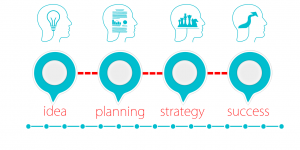Organizational transformation within a company is typically undertaken because it is believed that the transition will enable a firm to work at a higher level. The aim is to become more efficient, productive, in short, to transform the company into innovative and more profitable.
CONTENT
It’s also meant to keep up with new technological and economic developments; in some ways, organizations are forced to embrace change.
If change is poorly dealt with, however, it can become a double-edged sword, leading to a loss of productivity and poor employee performance. In this regard, you may find it worthwhile to read another article in which we discussed how to deal with resistance to change in your company.
Managers, including project managers, need to understand their role in change management.
Hence, here are some tips you can use to manage the change management process in your company more effectively.
What is organizational change?
Organizational change is the process in which a company modifies strategic or operational key components.
This may involve changes to the company’s culture, essential technologies, organizational structure, or key initiatives and objectives.
Organizational change is typically categorized into two types: adaptive change or transformational change.
- Adaptive changes are small, incremental changes that an organization makes to evolve over time and can be thought of as the tweaking of business processes and strategies.
- Transformational changes are larger in scope and scale and typically bring a major change in direction for the organization. These changes are often the result of external forces putting pressure on the company, such as the arrival of a new competitor.
Why does a company change?
Organizational change is the motion of an organization from one state of affairs to another.
A change in the environment often requires a change within the organization operating within that environment.
This change might be planned years in advance, be incremental and slow or, in cases of extreme urgency, be abrupt and drastic.
In any case, regardless of the type, change involves abandoning old ways and processes of working and adapting to new methodologies, strategies and visions.
Let’s see what can be the reasons for a company change:
- Organization demographics: The average workforce age is steadily increasing. The baby boom generation approaching retirement age and insufficient numbers of young workers are not helping to close the gap. Organizations may realize that as the workforce ages, the benefits preferred by workers may change. Work arrangements such as flexible work schedules and job sharing may become more popular as employees remain in the workforce after retirement. Thus, organizations need to formulate new strategies to address these different needs.
- Technology: Sometimes change is driven by quick technological developments that, over time, will become increasingly commonplace.
- Globalization: Globalization is another threat – an opportunity for organizations, depending on their capability of adapting to it. Due to differences in national economies and living standards across countries, organizations in developed countries are discovering that it is often cheaper to produce goods and provide services in less developed countries. Yet economies in countries are not static either, and given these changes, understanding how to manage a global workforce is a must. Managing employee stress from moving abroad, retraining the workforce, and learning how to compete with a global workforce are changes that companies must deal with.
- Market conditions changes: Market changes can also create internal shifts as companies must adapt. A very clear example of this is the Coronavirus pandemic that has literally upset the majority of industries.
- Growth: It is obvious for small startups to grow if they are successful, and as an organization grows, organizational change is required accordingly.
- Poor performance: Change can happen even if the company is underperforming and there is a threat perceived from the environment. In fact, poorly performing companies often find it easier to change compared to successful businesses. How come? High performance can lead to overconfidence and inaction. As a result, successful companies often continue to do what made them successful in the first place.
Tips for change management in a company
Here are five tips and strategies you can use to better manage change within a company.
1. Understanding change process
All change processes have a series of starting conditions – Point A – and an end point – Point B.
The change process is all that happens between these two points and includes several steps that are generally grouped into three phases: preparation, implementation, and follow-through.
Here’s what happens during each phase:
Preparation: the change manager focuses on preparing both the organization and its employees; this means helping employees understand the need for the upcoming transition and mapping out the vision and plan to achieve it.
Implementation: the change manager focuses on implementing changes in a way that is compatible with the company’s vision for the future.
Follow-through: the change manager focuses on ensuring that change is integrated into the company’s culture and operations.
2. Understanding forces of change
To effectively deal with change, managers must first understand why this is necessary.
Without doing so, it can be challenging to create a plan that tackles core concerns and fundamental questions such as:
- Which pressures are driving change?
- Are these internal pressures, like a new leadership?
- Are these external pressures, such as the development of new technology or the arrival of a new competitor?
If people understand the factors that necessitated an organizational change, they will be more likely to embrace it.
3. Create a plan
After understanding the reason for the change, you need to create a plan.
This plan should broadly outline why the change is needed, define its scope, determine key stakeholders, build a team and provide a detailed roadmap of the steps needed to complete the transition.
By having a defined strategy in place, it makes it easier to communicate the change to employees and monitor progress.
4. Communicate
When leading an organization during a time of significant change, clear and purposeful communication is one of the most powerful assets.
In short, leaders must be able to communicate change to two very different audiences: the first consisting of employees and the second consisting of management.
In the former case, these people must understand the need for change and the impact it will have on their job responsibilities.
In the second case, these people must be convinced that the change is necessary and, once they agree, they must be regularly updated on the status of the project.
5. Prepare for roadblocks
Regardless of how much you prepare for a change, often not everything will work out according to plan.
Even at the planning stage, it is critical to try to foresee potential roadblocks.
Once these obstacles are identified, even the most complex problems can be addressed and fixed.
As Heraclitus said twenty centuries ago, “Everything flows.”
In other words, change is a human constant and, consequently, it is also a constant in the business sector.
Adapting to and managing change therefore becomes a fundamental skill for dealing not only with the future, but also with the present.





